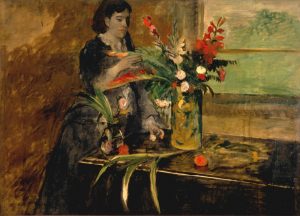How do you discover who your primary character(s) will be, in a story? Often, for me, the character comes first — I see her or him, leaning against a counter, or walking with a friend on a golf course, or chasing after a child, and the story comes to me through the character. Sometimes, though, it’s not so quick or direct, and I have to search — especially when the story is also one I am searching for, because it appears embedded and half-buried in history.
With Edgar Degas’ winter sojourn in New Orleans, in 1872-3, it was his gorgeous, odd paintings that touched me, and moved me. Each of them appeared to enfold some part of a larger story — possibly one filled with conflict and sorrow. I wanted somehow to write about that whole winter — to discover why these paintings of his cousins and family members held such intensity and power. I tried so many voices: Edgar’s; a servant child’s; 10 year old Josephine’s (Edgar’s cousin Tell’s daughter from Tell’s first marriage); Didi (Tell’s older sister). In each case, I was happy with some elements of the voice and the implicit story, yet I felt frustrated, because I just couldn’t get inside the character with honesty and a sense of truth.

One day, a new voice came to me — I don’t know how. Maybe I was simply ready for it. I wrote it down, just a floating paragraph, and I knew — this was it! I had discovered a voice for Tell (Estelle Musson Balfour De Gas, Edgar’s cousin and sister-in-law, who had lost her sight in her twenties). And with Tell’s voice, came her character. With each word, I found out more about her: how honest she was, and pragmatic, and loving. Also, how carefully she resisted knowing too much of the truth about her own marriage and her relationship to her cousin Edgar.
I had thought I couldn’t possibly write in this voice, because I wasn’t sure what it would have been like to have lost my sight by the age of 29, and to be pregnant with my fourth child in a rented mansion in New Orleans. How does a fiction writer ever have the courage to write a story outside of her or his own experience? I have to say, though, in this case, I got lucky. I started to listen to Tell, and she was happy to let me in. It was a great relief. From that first floating paragraph on, I came to know her, as fully as she would let me.
Hello, I just finished reading “Lydia Cassatt Reading the Morning Paper”. I loved your story, I even loved the book itself; the cover, the pages, the paintings throughout. Just a beautiful book.
The story was so moving, so personnel, so loving. Thank you for all the enjoyment!
Now on to “The Lost Sketchbook of Edgar Degas”.
Thank you so much, Ann Marie! I’m so happy you enjoyed this novel. Thank you for writing!
My best wishes,
Harriet